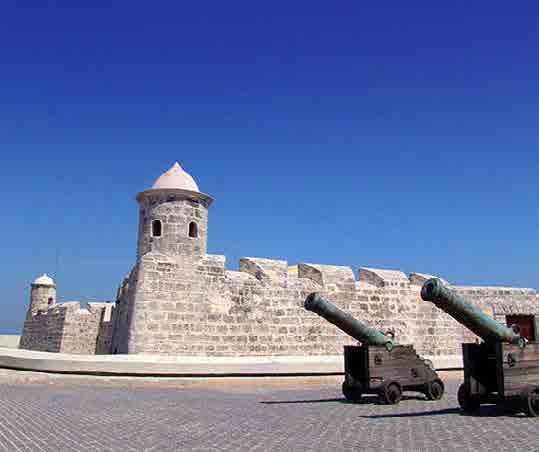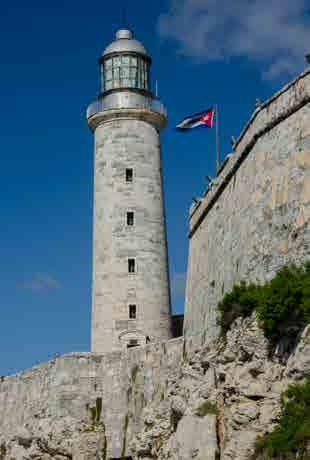
4 minute read
FortiFiCaCiones Coloniales en la Habana
Bordeada de mar, La Habana se muestra serena. El rompiente de las mareas; el ir y venir de sus habitantes y sus antiguas fortalezas, la enriquecen y definen, como la urbe cosmopolita que es. La capital cubana recibe al visitante ávido por develar sus más furtivos secretos y desde su Centro Histórico, cual excelente anfitriona, revela detalles desde su fundación como Villa de San Cristóbal de La Habana.
Colonial fortresses in Havana
Bordered by the sea, Havana looks calm. The breaking of the tides, the comings and goings of its inhabitants and its ancient fortresses enrich and define it as the cosmopolitan city it is. Havana welcomes the visitor who is eager to unveil its most hidden secrets and from its Historic Center, as an excellent hostess, reveals details since its foundation as Villa de San Cristóbal de La Habana.
Textos/Texts: Bienvenidos
Fotos/Photos: Bienvenidos-Publicitur S.A.

Asentada definitivamente, en 1519, junto a la bahía, ser puerto de tránsito y provisión para la flota española, contribuyó a su asedio por parte de piratas y filibusteros. Fue entonces, que se levantaron castillos, puentes, baluartes, plataformas, fosos y murallas, para intentar contener los ataques. Esas extraordinarias construcciones cuentan hoy la historia apasionante de la ciudad.
Para llegar a conocerlas, cada día su Centro Histórico Urbano y su sistema de fortificaciones -Patrimonio Cultural de la Humanidad- se llena de cubanos y turistas. Y es que estas fortalezas, además de estimular la imaginación, trazan un estupendo recorrido a través del legado arquitectónico y cultural de los pasados siglos XVI, XVII y XVIII.

Settled definitively in 1519 next to the bay, being a port of transit and supply for the Spanish fleet was a fact that contributed to its siege by pirates and freebooters. It was then that castles, bridges, bastions, platforms, trenches and walls were built to try to halt the attacks. Today, these extraordinary constructions tell the exciting history of the city.
To get to know them, every day its Historic Urban Center and its system of fortressesCultural Heritage of Humanity- is full of Cubans and tourists. The fact is that these fortresses, in addition to stimulating the imagination, trace a wonderful journey through the architectural and cultural legacy of the past 16th, 17th, and 18th centuries.
Castillos defensivos
El Castillo de la Real Fuerza fue la primera fortaleza amurallada que se levantó en América. Convertida en museo, protege y exhibe varias colecciones de piezas, junto a imágenes y réplicas de embarcaciones de la época colonial. En ella, todo es atractivo: sus paredes, su foso, su puente de madera, sus baluartes, sus bóvedas y cañones, su historia y hasta sus leyendas. Una de ellas relacionada con el amor, dio como resultado uno de los símbolos de La Habana: La Giraldilla. Y allí, en la torre campanario, inmortalizada en bronce, la enamorada vigila la bahía. A la Real Fuerza le siguieron el Castillo de San Salvador de la Punta y el de los Tres Reyes Magos del Morro, cuyas construcciones se iniciaron a final del siglo XVI. Ambas en su momento fueron por su posición, las más importantes del sistema defensivo de La Habana, para impedir el acceso a la rada citadina.

Defensive castles
Castillo de la Real Fuerza was the first walled fortress built in America. Turned into a museum, it protects and exhibits several collections of pieces, along with images and replicas of ships from the colonial period. In it, everything is attractive: its walls, moat, wooden bridge, bastions, vaults and cannons, its history and even its legends. One of them, related to love, resulted in one of the symbols of Havana: La Giraldilla. There, in the bell tower, immortalized in bronze, the lover watches over the bay.
The Real Fuerza castle was followed by Castillo de San Salvador de la Punta and Castillo de los Tres Reyes Magos del Morro, the construction of which began at the end of the 16th century. Both were at the time, due to their position, the most important of the defensive system of Havana, to prevent access to the city’s bay.


En la actualidad, San Salvador de la Punta resguarda entre sus muros coloniales, el Museo de la Marinería. Sus bóvedas interiores exhiben hallazgos y botines de naufragios pertenecientes a los siglos XVI, XVII y XVIII; restos e imágenes de los pecios que han sido encontrados en las costas de Cuba y otras evidencias de época.
El Castillo de los Tres Reyes Magos del Morro, ubicado en la ribera este del canal de entrada al puerto se ha llevado la preferencia entre las fortalezas coloniales, por su pétrea belleza convertida en símbolo de la ciudad. Posee tres baluartes, un profundo foso y dos baterías: Los doce apóstoles y La estrella, convertidos en restaurantes donde se puede degustar comida internacional y cubana, con una excelente vista al mar.

El faro del Morro ilumina las noches habaneras y sirve de guía a cuanto navío se aproxima a la costa de la capital. Desde su altura se aprecia La Habana, conmovedoramente extensa y seductora, ante la mirada curiosa de quien pretende conquistarla.

Currently, San Salvador de la Punta has within its colonial walls the Museo de la Marinería. Its interior rooms exhibit findings and booty of shipwrecks belonging to the 16th, 17th, and 18th centuries; remains and images of the wrecks that have been found offshore Cuba and other evidences of the time.
Castillo de los Tres Reyes Magos del Morro, located on the eastern side of the entrance channel to the port, is the most popular among the colonial fortresses because of its stony beauty, which has become a symbol of the city. It has three bastions, a deep moat and two batteries: Los Doce Apóstoles and La Estrella, turned into restaurants international and Cuban food can be enjoyed with an excellent view of the sea. The Morro lighthouse illuminates Havana’s nights and serves as a guide for any ship approaching the coast of the capital. From its height Havana can be admired, vast and seductive, before the curious eyes of those who intend to conquer it.











